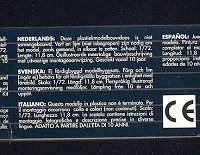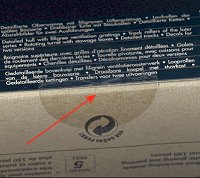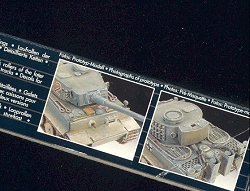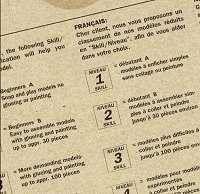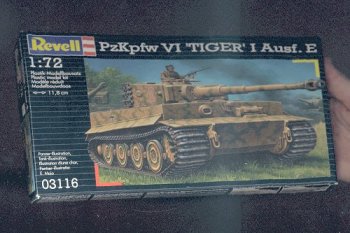 As one can see in the scan above, this kit comes boxed in Revell's now-standard, two-part, black cardboard box, with horizontal gray lines. The size of the box is perfect for storage in copy-paper boxes, where a row of Revell kits will fit perfectly standing on end, unlike the old ESCI boxes, which were too tall to fit neatly within this common type of storage box. The majority of the box top is filled with the awesome artwork from Enzo Maio. (A little side-bar here: several years ago, Jim Matthiessen and I co-authored a comparison article of the Hasegawa Tiger I and Revell Tiger I Ausf. H kits. One of the points that Jim made was that the boxart on the Hasegawa kit [done by Enzo] was much nicer than the Revell boxart [not done by Enzo]. Since that time, Revell now has Enzo do their boxart. Coincidence? I think not.) The box title is clearly printed in a large, white font, which makes it very easy to read from a distance. This same feature is thankfully repeated on the ends of the box as well, so that when viewing this kit in a stack of similar kits on a hobby shop shelf, the kit is easily identifiable. The sub-text is presented in a similar, but sans-serif font style, in a smaller size. This serves well to divide the text into sensible sub-sections for easy reading.
One side of the box has some background information and specific kit information presented in seven different languages. I assume that each block of foreign text provides the same information, but without being able to read these other languages, I'll just have to assume that it's correct. The kit description specifies that the kit is composed of 182 parts, but since I have not yet opened the box, I cannot independently confirm this fact. Since Revell has been fairly reliable in the past for this type of data, again, I'll have to assume the box is correct. It also states that decals are included for two different vehicles; the presence of the decal sheet can be confirmed by shaking the box from one side to another, and hearing the decal sheet slide around inside. Whether or not there are two sets of markings on the sheet, is still awaiting further research. Also noticeable when shaking the box, is the sound of the plastic parts moving around inside. They have obviously been sealed within an internal plastic bag, which is beneficial for keeping handy any parts that may have inadvertently broken off the sprues from morons who like to shake boxes. From past experience, I feel that Revell has some of the best plastic bags in the business, being very clear, and thin, yet tough, flexible and well sealed. Although, sometimes they are too tough, and need to be cut open with a scissors, instead of being easily pulled apart at the ends. I feel that Hasegawa beats Revell in this regard.
However, one deficiency noted by many American modelers, is the lack of shrink-wrap on the outside of the box. Instead, Revell simply seals their boxes with two circular, clear plastic stickers. While this is certainly acceptable to adequately seal the box without having anything fall out, the typical spoiled American modeler is used to having all of his kits shrink-wrapped, so that he can be "assured" that he is getting a kit that has never been touched by human hands before. But I must point out this assumption is often incorrect. I was in a hobby shop last year right after they had received a shipment of several dozen Fujimi armor and aircraft models. Like all models NOT produced in the USA, these did not have shrink-wrap, so I was able to look through all of the models before they went on the shelves. The hobby shop staff were furiously working at shrink-wrapping all of the kits with their own shrink-wrap machine, before they received any complaints from the customers (true story). Back to the kit . . .
On the other box side, there are several small photos of a completed model, presumably of the model that is inside the box, but how can I be sure? This is something I cannot confirm without opening the box, so you viewers will just have to take the risk yourself that the model you are buying is actually the one pictured on the box. As far as the pictures are concerned, they are very small, and printed with low resolution, but they are still adequate to clearly portray the [supposed] box contents. The photo composition is also very well done, with excellent cropping, and centering of the subjects. [Post-script: Pat Storto sent me an email after I originally posted this article pointing out that in fact, the photos do NOT show what is actually in the box. Rather, they depict the Tiger I Ausf. H, and are photos of the same model that is pictured on the side of the Ausf. H model box. This just goes to show that research is very important when buying models!] The box was printed in Germany, which would explain the high quality of the printing, and the perfectly square corners. I really love that German engineering. Also encouraging is the fact that the model is made in Korea (I assume that means South Korea), for as we all know, only models made in Korea are any good. Forget about all the other model manufacturing facilities around the world. If it's not made in Korea, it's garbage. The box is held together with a single, brass staple in each corner, but I think this is incorrect. Instead of staples, I believe that this version of the box was supposed to have the corners glued together. Only the 1999 versions of Revell boxes came with staples (and even so, the staples on this box are an incorrect size anyway - they should be 2mm longer).
To finish this in-box review, we get to the bottom of the box. This is made from simple, brown cardboard, with a printed key to the Skill Levels. I strongly feel that this is the weakest part of this kit, since there is so much more that could have been done with this space. Revell could have easily spent an extra penny by printing here some paint schemes, or their catalogue of upcoming kits, or even a good recipe for spaetzle. But instead they printed some utterly useless information. Perhaps we can rely on some aftermarket company to provide some more useful material for us, so we won't have to spend the extra effort actually doing anything ourselves. So all in all, I think this is a pretty decent kit. While it has some weak spots, I truly believe that Revell produces some of the best model boxes in the industry today. Highly recommended for those modelers who like small scale WW II German Tiger tanks; and no one else. If you like T-34s, don't even think about buying this model. And if you're an aircraft modeler, well, what can I say? You shouldn't even be reading this review in the first place. |
